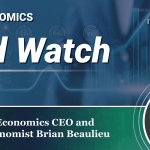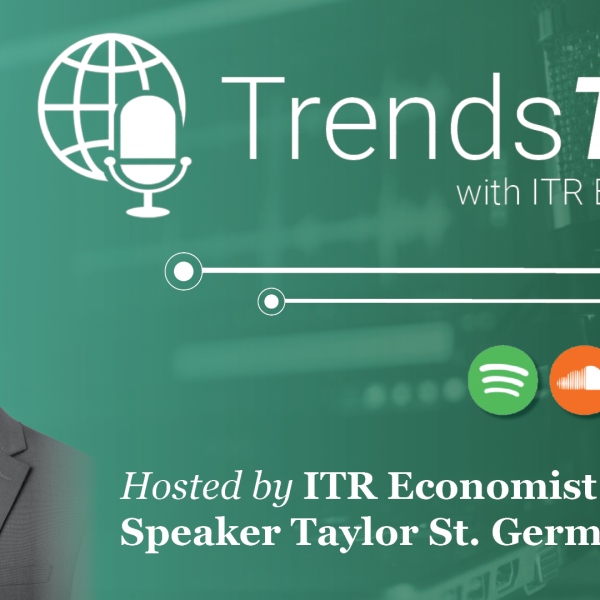- Mon - Fri: 8:30 - 5:00
- +1-603-796-2500
- ITR@itreconomics.com
April 22, 2024
- Home
- portfolio
- TrendsTalk
- April 22, 2024
with Taylor St. Germain
MACROECONOMIC TRENDS, LABOR, AND INFLATION
ITR Economics Director of Economics Grace Schatz joins host Taylor St. Germain on TrendsTalk this week to discuss the labor market, our US Industrial Production forecast, inflation trends, and more!

MEET YOUR HOST
Taylor St. Germain
As an experienced economist, Taylor St. Germain provides consulting services for small businesses, trade associations, and Fortune 500 companies across a spectrum of industries. His dynamic personality and extensive knowledge of economic trends and their business relevance are highly valued by clients and colleagues alike.
“Join me on the TrendsTalk podcast to explore the world of economics. Episodes offer insightful discussion and expert interviews. We cover relevant economic concepts in an accessible way. Whether you are a curious layperson or an industry professional, TrendsTalk is your go-to source for thought-provoking analysis and a deeper understanding of the economic forces shaping our world.”
Key Episode Takeaways
- 0:23 – Welcome ITR Economics Director of Economics Grace Schatz to the podcast
- 1:05 – 2Q24 Update on US Industrial Production forecast
- 1:30 – Key indicators we are watching closely to assess the weakness in the industrial economy
- 3:32 – US Manufacturing data trends and analysis
- 3:57 – Know your market and datasets
- 4:49 – Further discussion on leading indicators
- 6:50 – Downside risks to our forecast
- 9:02 – Upside risks to our forecast
- 11:55 – Discussion on labor market dynamics
- 15:40 – Make the most of these next five years before the 2030s depression
- 16:10 – Recent inflation trends and its impact on both consumers and businesses throughout 2024
- 18:55 – Speculation on potential actions from the Federal Reserve Board
- 20:30 – Summary and conclusion
The below transcript is a literal translation of the podcast audio that has been machine generated by Rev.
Taylor St. Germain:
Hi everyone. Welcome to this edition of Trends Talk with ITR Economics. My name is Taylor St. Germain, and we at ITR Economics are your unbiased and apolitical source of economic intelligence. And today’s a special episode. We have a guest on today’s episode. Our guest is Grace Schatz. She’s the Director of Economics here at ITR. And today Grace and I are going to discuss macroeconomic trends. We will chat about the labor market and inflation, some of these high level topics that we’ve been receiving a lot of questions on throughout the beginning of 2024. So I wanted to have Grace on so you could hear straight from the Director of Economics in terms of her thoughts on the economy. So thanks so much for being here, Grace. We really appreciate it.
Grace Schatz:
You’re welcome. You’re really talking me up. I hope I live up to it.
Taylor St. Germain:
I have no doubt that you will. For all of our listeners, we’ve talked a lot about US industrial production for all of our Trends Report subscribers and followers of ITR, US industrial production is a very important series to us and our clients, and we’ve discussed it at length over the last few quarters, but I wanted to provide an update as we sit here early in the second quarter of 2024.
I’ve been talking Grace a lot about weakness in industrial production in 2024 as we see these rates of growth retreat closer and closer to zero for the industrial economy. And so I wanted to hear from you. What are some of the key indicators that you’re watching closely to assess the weakness in the industrial economy? Or the recovery that we’ve been talking about in 2025? Can you give us some perspective on some of your favorite leading indicators?
Grace Schatz:
It’s so hard to pick favorite leading indicators when you’re in this job, but I’ll take a stab at it. I think when I’m thinking about industrial production right now, the first thing I’m thinking about are the components because they’re all doing something just a little different and we’re holding our breath when that data gets released because we’ve seen that waffling around zero. Is it going to go below or is it going to just stay above zero? So the reason that’s happening is because the components are not in sync with one another. Utilities is kind of waffling like the total is. Mining is pretty strong. That’s not just that metal mining part. It’s oil and gas that’s really driving the total. Remember, industrial production is an output-based index, so it’s not necessarily dollars flowing. It’s how much of any given good is being produced through our system. So when we have that oil and gas tap flowing, that is going to juice industrial production and it is doing that in the mining segment right now. And I think we’re hearing that from clients too. Don’t you think, Taylor?
Taylor St. Germain:
Certainly. Yeah. It’s interesting in a downturn, usually in industrial production downturns, oil and gas is part of the problem. And it seems opposite this cycle, at least when we compare to some of the previous downturns, that most of our clients are seeing growth year over year still in that space.
Grace Schatz:
Yeah, it’s a little unusual in my 10 years of working here. Nice to see a little variation there. Gives me more to talk about when it comes to these different components. But that leaves us with the largest component, manufacturing to still talk about. That segment has already been declining. So if you just look at manufacturing on its own, that waffling isn’t happening. Yeah, it is little below zero, it’s mildly below zero. And a lot of that has to do with how many different markets blow into that manufacturing production. They’re not all doing the same thing. And so this is another case where we go down to that next level and we see just something different depending on which market you’re looking at.
So one thing I want your listeners to take away from this part of the conversation is know your market. Know what data sets you should be looking at in terms of a benchmark. Knowing where the industrial economy is going is super important, don’t get me wrong. It’s a big part of what I talk about here. But your business may not track with the overall industrial economy given how much variation we’re seeing segment to segment.
Taylor St. Germain:
And my shameless plug for our Trends Report, you can see some of those breakdowns in terms of these individual segments that make up that manufacturing sector. And some are in the negative growth rate territory year over year, but there’s several that are positive. So I think that’s a really important point.
Grace Schatz:
Yeah. To answer your question about leading indicators, I think when I look at those components and we kind of cobble them back together, that weakness that we’re seeing overall that’s causing the waffling around zero is still indicated by some of the indicators that we’re monitoring. One that comes to mind for me is persistent decline in utilization rates. That matters for the industrial economy. I’ll also say that interest rates staying as high as they’re staying normally deters investment. And so I think it’s important for us to be looking at not just the directional movement of some of these indicators, but also the overall story.
Taylor St. Germain:
I think it’s fair to say that in this cycle it’s a bit unusual, especially as we come out of that crazy pandemic cycle, that some of the leading indicators that we’ve looked at historically are giving us signals that they have in the past. But there’s a lot more complexity to this new reality of this economy that has us digging a lot deeper into really ripping apart these indicators and sub-segments because there’s so much nuance out there.
Grace Schatz:
Yeah, I think that when we look at some of those leading indicators, the ones that I love to see are the ones that are already rising, that tell us that we’re going to see that the cycle is likely to be short, that any decline we see is likely to be brief. That gives us hope for the future and solidifies some of those plans for investment that we’ve been recommending our clients make.
That doesn’t mean it’s clean though. Our explanation on the lead times is a little different in this post-Covid period. And so it’s hard to understand where the indicators are telling you your business is going. But that’s a little ray of sunshine on my cloudy day. I’d say that rise in the leading indicators tells me that there are good things happening underneath even though we have some worry about the utilization rate and interest rates.
Taylor St. Germain:
And along the lines of risks to our forecast, could you share with us an upside risk that you’re concerned about, and a downside risk? Where would you like to start?
Grace Schatz:
Well, I guess we’ll start with the bad news. Then I get to move over to the sunny side. For me, the bad news is that inventory levels are still really high, and that’s not bad for everyone in the economy, so I don’t want to paint it in such a black and white perspective. But since you’re asking me about risks to industrial production, if we have high levels of inventories, we won’t have as much incentive to make more of whatever that item is. There won’t be as much demand pull on those manufacturers. And so really when I talk about this as the downside risk, I’m thinking to the manufacturers, to those people on the production side. Overall inventories, they hit a record high in 2023, they’ve been coming down a little on the total, but that decline has been really mild. And there are big differences segment to segment as well within inventories that I think are important to note. Some are just doing better than others.
So just a few categories that I’d want your listeners to focus on, or at least if you’re in one of these spaces, look into what the inventory situation is because it may be affecting your business. One is motor vehicles. Inventory levels in that segment are just really high. They’re up over 16% from this time last year on an annual basis. And machinery overall is also in that category, growing at a 19% plus annual clip. So those two segments are going to be especially prone to downside risk based on existing inventories on the manufacturing side.
But we also have some segments, particularly on the non-durable side, where inventories are already starting to come down pretty significantly. And so I think it’s important to note that it’s not a one-size-fits-all risk when it comes to industrial production. But motor vehicles and machinery make up a pretty good chunk of that manufacturing segment, and that’s why it comes to mind for me as a pretty significant risk on the downside.
Taylor St. Germain:
And anecdotally when I’ve been traveling for the first four months of the year, inventories is the number one challenge, it seems like overwhelmingly as well. We look at a lot of inventory data ratios in terms of inventories to sales ratios. So we have a lot of great data too, if any of our listeners are looking for some perspective on where inventories might be in their particular industry. So what about the upside risk? And again, we view risks as we want our accuracy of course, but I think upside risks, you can be a little bit more excited about them.
Grace Schatz:
Yeah, I like the sunny side of things, so thanks for letting me share that one too. There are two categories I’m looking at that seem to have a bit more positive side risk, or companies that are associated with these two segments I think should look for those opportunities a little bit harder. The first is anything that’s technology-based, high-tech. There’s been a lot of investment into the tech space. That includes tech goods, not just tech services. So high-tech goods are part of US industrial production. And when we look at just that segment of high-tech goods, what the Federal Reserve Bureau calls high-tech goods, that’s in a pretty solid phase B in a double-digit growth phase. So it’s a small part of the overall US industrial production, but it matters a lot, especially to businesses that are in that space.
And the second thing I’d say is government spending. There has been government spending through the Infrastructure Bill. We have CHIPS Act, but then we have just generally government spending being extremely high relative to historical norms. That flows into the economy in a variety of different ways. I hope that the listeners can think about how government spending might affect the markets that they’re already serving and try to target some of their resources toward gaining ground there.
Taylor St. Germain:
Great. Yeah, and I think when we look at 2024, that’s what it’s all about. It’s about finding these counter-cyclical markets. It’s markets at the bottom of this economic cycle for industrial production that’ll be performing better than others, so we can spend some more time as businesses focusing our efforts there. Now, we’re talking about some weakness in ’24, but as you alluded to, leading indicators are pointing up already for some growth in 2025. And again, for our listeners, they know I’ve been talking a lot about preparing for this 2025 and 2026 rising trend. And even though the economy’s weaker, we really see 2024 as time to make the moves to be prepared for what’s coming in ’25 and ’26 with all this demand returning.
That brings me to labor. Labor is, of course, always a challenge. It’s not just a challenge today, but it seems like it always is no matter where we are in the cycle. But I think it’s very important. We’ve talked about labor in the past on the podcast, which is really using ’24 to be hiring, focusing on retention and training so that we are prepared to take on this demand in ’25 and ’26. So I was curious, what are your thoughts on the labor market dynamics today? And what do you think businesses should consider in 2024 to be preparing for the growth that we’re expecting really to characterize the second half of this decade?
Grace Schatz:
For many of our listeners, your business is very local to where you are. And so just a little caveat. What I’m talking about is more national trends. You might be in a specific situation, but I think this applies even to people that are in a very tight labor situation or a looser labor situation.
So the first thing I’d want you to know is that there are investments to be made in technology to help the people you have work smarter. And that’s going to be important for two reasons. One, I think you were alluding to labor availability, but I think the second piece of it is persistently high wages that are just going up from here because of inflationary pressures. So those two factors combined mean that the people that we do have on staff need to be as efficient as possible. There’s technology that can enable that, but it requires investment to make it work, not just in researching and understanding what technologies they are, but actually implementing it. It takes time.
I know we’re sitting here in April 2024, 2025 might seem far away to some of our listeners or even 2026. Some of this technology takes a long time to implement, so start thinking about it now if you haven’t already done that. This is something that could make a big difference in terms of how much labor, or the external labor situation, affects you and how you’re able to operate your business.
I think the second thing I’d want you to know is that the focus needs to be on growing market share. So those hires that you make, are they making the difference in terms of growing what you’re able to do? So an example might be, could you hire somebody in a new sales territory to expand your market share within your region? That would be an investment into market share growth that would be highly beneficial during a period of general rise.
Taylor St. Germain:
And again, I think it’s counterintuitive, right? We talk about weakness in the economy in 2024, but that’s very intentional on our part because we’re always thinking that business cycle ahead. So even though there’s some weakness here today, now is the best time to be, like you had mentioned, implementing, whether it’s hiring or investing in new efficiencies to be prepared to take on this growth. I’ve been saying a lot I’m not concerned about businesses surviving ’24. I’m concerned we are not prepared for ’25 and ’26. And that’s why I think it’s so important to make these moves now because we don’t want to be turning away growth because we don’t have the capacity as this next economic cycle, next rising trend really takes hold in 2025.
Grace Schatz:
Yeah. I mean, as you know, looking beyond that rising trend, that short-term horizon, we see a potential for a depression out there. And so all of these periods where there is going to be growth, you have to take fullest advantage of those in order to solidify your competitive advantages, to solidify your market share, so that you are best positioned for when the economy does start to pull down on your business.
Taylor St. Germain:
And of course, everyone, Grace is mentioning our 2030 expectation that we’ve talked about on the podcast, as well on a previous episode. And yeah, I think that even when I chat with my individual clients, I’m saying we’re not just preparing for growth in ’25 and ’26, but really to characterize industrial production for the second half of the decade. But it’s so important that we take advantage of these five years, because to your point, we have of course, the 2030s. That really isn’t that far away at this point in time.
Grace Schatz:
The clock is ticking.
Taylor St. Germain:
Yes, it sure is. The last question I had for you, Grace. Of course, I think everyone’s paying close attention to inflation, especially as the Fed alluded to earlier this year that they expected to lower rates. And it seems clear that that’s still their expectation, but I think it’s safe to say that’s been delayed from what they initially anticipated because these inflation numbers have remained elevated. I’ve talked about the difference between consumer inflation and producer inflation on our previous podcast, and there is a little bit of a difference there. But I guess from an overall perspective, how do you perceive the recent trends in inflation? And how does that impact consumers and businesses as we move forward throughout 2024?
Grace Schatz:
I think it impacts businesses in terms of forcing more creativity about how they’re going to grow their top-line business. There are many businesses I work with that are used to being able to raise their prices even just a little bit year over year in order to be able to get that juice in their overall growth rate. That may not be possible for a lot of our industrial businesses this year or even next year. And so really asking the business community to be a bit more creative about developing competitive advantages. How can you sell on the value that you provide so that you can keep those growth rates at least stable? We don’t want to be selling on just on price whenever possible. So how can you use this period to think creatively about how to get away from that pricing model towards something that’s more value-driven? So on the business side, that’s one thing that I would encourage businesses to think about.
On the consumer side, I think we’re seeing people spend money on different things than they usually spend money on, and that means that there’s pressure on the consumers. They feel that the economy is doing worse. They feel the economy is putting pressure on them to make different choices. I think it’s true that that’s happening. Businesses have to understand that reality and tailor their offerings to that new, I guess, reality of a squeezed consumer. If consumers are squeezed, what kind of goods are they more likely to purchase under those conditions, and change their business strategy to focus on those types of goods.
Taylor St. Germain:
Yeah. Yeah, I think when we talk about raising prices, our President, Alan, yesterday in a meeting said, “Raise prices based on value, not cost.” And I think that aligns very well with what you’re saying along the lines of the competitive advantages.
In terms of interest rates, it seems, again, I think the consensus here at ITR is that we would expect to see some interest rate decline in the second half of the year, but maybe not at the magnitude that we’ve seen previously. And our CEO Brian with his Fed Watch will keep everyone updated there. But do you have a similar perspective? What are your thoughts with what we might see from the Fed in terms of interest rates, and knowing that the Fed makes their own decisions independent of us, but what are your general thoughts there?
Grace Schatz:
I wish I knew. That would make my job so much easier, wouldn’t it? I would love to know what’s in their head. What I’m sensing from what I’m reading and what I’m seeing is that slow and steady is the way that they’re going to want to take this because of how sensitive all of these pieces seem to be to interest rate changes. And I think it’s smart from their perspective to try to be slow and steady, but understanding that expectations of what they’re going to do has real effects on the economy as well.
In my position as Director of Economics here, we have to contend with the real level of interest rates, but we also have to contend with what people are expecting in the future and that matters too. So I’m not sure that totally answers your question, Taylor, but I wish I knew. If I were in their shoes, I would definitely be taking it slow and steady from a perspective of communicating out the expectations that they have of how they’re going to change things. Because we see that the market moves not just on what actually happens, but also what they’re signaling is going to happen.
Taylor St. Germain:
Yeah, communication and sentiment is important from the Fed. It’s always so interesting to see how the market reacts the day after these Federal Reserve meetings. And of course, we’ll keep you updated. Like I mentioned, Grace and I will be here on Trends Talk in future episodes to discuss this. But certainly check out our CEO’s podcast, Fed Watch, which comes out every Friday, and he will be sharing updates on what’s going on with the Fed there. So thank you everyone for joining this episode of Trends Talk. Just as a reminder, please like and subscribe to Trends Talk wherever you listen to your podcasts. And Grace, thanks so much for being on today. I really appreciate it.
Grace Schatz:
Happy to do it.






